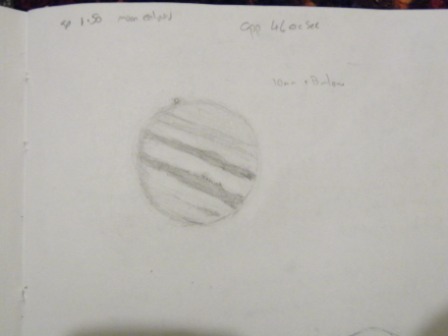Ok, I’m going to confess. I decided I am bored of looking at Jupiter. Yes, I know…”how could you?!” Well during my last two observing sessions I barely gave the King a second naked eye glance, let alone swing the scope on to ‘His Highness’. When I thought about it I decided I was a little bored of Jupiter.
Turn the clock back to August and a warm, dreamy night in Regent’s Park with the Baker Street Irregulars. We stood under a midnight sky, surrounded by the last die-hards who kept muttering it was probably time to go home, but all desperate to pay homage to the newly risen master of the sky and all eager to peer through the murk of the horizon and see that distinctive flattened shape and dark equatorial belts.
Weeks later I was setting my alarm (to the annoyance of the OH) for 2am when I knew Jupiter would crest the house behind our garden and allow me a first good sketching session. There sat the Jovian System, Ganymede eclipsing, belts slowly wavering and subtly changing over the hours before dawn, totally mesmerizing and demanding my attention, which I was all too happy to give.
But now Jupiter sits in the west, slowly retreating from Earth, up in the sky at such a sociable time that I could observe before dinner and I can barely look the gas giant in the face.
Then it occurred to me, do I even know what I was looking at? What are those dark equatorial belts anyway? Before I wrote Jupiter off for the season I decided to investigate…
The stripes. Anyone who has seen a picture of Jupiter has seen the stripes and even in a small telescope Jupiter doesn’t disappoint, those dark orange-brown belts tell you that you have definitely found Jove and never cease to wow the public looking for the first time. But what are they?
‘Clouds’ is the simple answer but what does that mean?
Well here the Jupiter story gets more interesting because the answer is not a certain one and of course uncertainty is what makes science interesting. While measurements have been taken and much is known about Jupiter, much more of this planet is just educated guess work and computer modelling. So while the bulk of the planet is Hydrogen and Helium, the colours (are thought to!) correspond to areas of different temperatures and the condensation of various chemicals, with Ammonia showing up as ice crystals in the lighter bands and various Sulfur-chains (such as Tetrasulfur tetranitride S4N4) having a big role in the darker coloured bands. All this is part of a complex and barely understood process of chemicals welling up from within Jupiter and reactions with sunlight.
Then there is the wind speed. Those bands that sedately pass through your eyepiece are moving at breath-taking speed.
160-220 metres a second.
357-492 miles per hour to you and me.
Thousands of storms full of exotic chemicals, tearing around a planet 1321 times larger than Earth, at incredible speeds and all spinning on its axis in ten hours. All this from my back-garden on a cloudless evening. And the professionals aren’t certain. Bored?!
Maybe I will give Jupiter one more look…
(Information on Jupiter from introduction to the Solar System, Rothery, McBride and Gilmour, OU Press)



One source I read claims the differences between the tone of the darker belts and lighter zones is due to the relative heights of the clouds in each feature.
Its fascinating that essentially we don’t know for sure, we feel we know Jupiter, it’s been observed for hundreds of years and been known probably for all of Human history. The things I were reading suggested that its due to temperature differences, lighter being warmer.